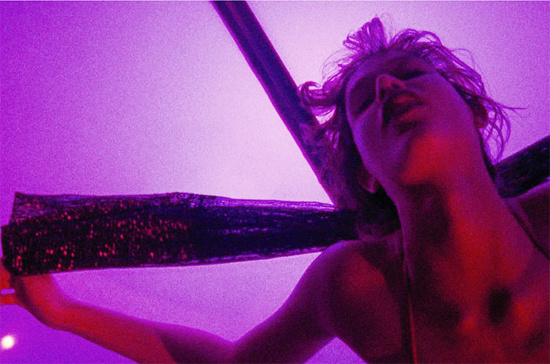Gaspar Noé seems to have a passion for fucking with the classics. Pachelbel’s ‘Canon in D’ turns up at the end of his brutal, frontal assault of a debut, I Stand Alone and the haunting string refrain from the Adagio of Mahler’s Ninth Symphony rises with the camera at the start of Irreversible, half submerged in quavering electronic noise, a 40 db drone specifically designed to make its audience feel nauseous. Just as often though, classical music serves to evoke some wistful state of prelapsarian innocence. The Allegretto from Beethoven’s Seventh which drifts up into the clouds at the end of Irreversible, and in his new film, Enter the Void it’s Bach’s ‘Air on a G String’. Yes, the happiness-is-a-cigar-called-Hamlet music. But not the syrupy instrumental version that used to accompany Russ Abbott’s smug face back when advertising tobacco products on television was still legal. Noé uses Delia Derbyshire’s electronic version, as featured on the BBC Radiophonic Music ‘pink’ album. “We heard many, many different versions of that ‘Air’ by Bach by different interpreters,” he tells me between gulps of coffee, a little after ten in the morning in a Soho office block, “but I still thought the sweetest one was that electronic version by Delia Derbyshire. That’s the kind of music I listen to when I am at home.”
Enter the Void is a film about psychedelic drugs, conceived on psychedelic drugs, and which attempts to replicate the experience of taking psychedelic drugs. Introducing the film at last year’s London Film Festival, Noé recalls, of his teenage experiments with hallucinogens, thinking, “Why does no film look like this?” Now, thanks to a first-person perspective gimmick borrowed from Robert Montgomery’s late 40s noir thriller, The Lady in the Lake, and some digital imagery which takes Jordan Belson’s visuals for Demon Seed to a whole other level, I think the director’s adolescent self would finally be satisfied. Of course, for such a trippy film, what better choice of location than the world’s most lysergic city: Tokyo. “You have all these lights, that you can find in Hong Kong as well, but I don’t think people do drugs in Hong Kong.” The story charts the descent of two ex-pat American teenagers (Nathaniel Brown and Paz de la Huerta) into drug dealing and strip joints. “I thought that if you move these two American characters to Tokyo, you feel like they are two small animals lost in a huge pinball machine that doesn’t care about them.” To match the pachinko fluorescence of the set, a panoply of psychedelic musicians were enlisted for the soundtrack.
The film sees Noé reunited with his fast-becoming-regular musical collaborator, Thomas Bangalter, better known as one half of Daft Punk. “I always like working with him,” he says, “because he is extremely intelligent and he is a very good film director.” For Bangalter is more than just a boy wonder of new French disco, he was also the cinematographer, co-writer and director of Electroma, an existential tragedy about two lost robots, not to mention scores of music videos. Bangalter was too busy working on The Tron Legacy to compose all of Enter the Void‘s music, instead he gave Noé a palette of drones and ambient sounds to be mixed in, contrapuntally, with a wide range of experimental music, and electronic music from the 60s and 70s, in order to create “a maelstrom of sounds.”
The list of music mixed into this ‘maelstrom’ reads like a weird music fanatic’s wet dream: the ‘spectromorphological’ electroacoustics of Denis Smalley, the glass harmonica playing of Thomas Bloch, Toshiya Tsunoda’s ‘Music for Baby’, and Alvin Lucier’s ‘Music for Gamelan Instruments, Microphones, Amplifiers and Loudspeakers’; the twee concrète of Japanese group Lullatone, and the ambient noise music of Polish composer Zbigniew Karkowski. All these different sources (and more) are mixed and blended “like a river, where all the waters are mixed inside,” blended beyond distinguishability. A few tracks stand out: the first part of Coil’s ‘Ans’ rippling underneath Oscar’s first DMT trip, and LFO’s punishing electro smash, ‘Freak’, hammering out over the opening credits. The purpose of all these drones and psychedelic fantasias was not just to enhance the image but to put the audience “in a kind of altered state of perception.” This is Noé the director, not of images and stories, talking, but the director of bodily states – your bodily states. He quotes approvingly to me from an article he once read which described him not as an art house director but a “rollercoaster builder.”
“It’s not very common,” he admits, for film-makers to mix sounds and music in this way, forging such a ‘maelstrom’ as he puts it, from such varying sources. The influence for such an approach, perhaps unsurprisingly, was not cinematic, but itself a piece of music: “’Revolution No. 9′. That was my main reference point when I was talking to Thomas Bangalter or other musicians. I wanted the whole movie to sound like The Beatles’ ‘Revolution 9’ – where you catch the beginning of a note, or of a melody and then it’s already somewhere else.” It’s a neat image of the workings of sound and music in our memories and in our dreams.
And floating over all of this, drifting in and out, that famous ‘Air’ by Bach that everybody knows, here acting like a leitmotif for Oscar’s childhood memories, and for his relationship with his sister – like Noel Coward’s famous saying about the potency of cheap music. As in Irreversible, also I Stand Alone, where the ‘Canon in D’, coming immediately after the film’s most brutal moment, and immediately before one of its most perverse, nonetheless seems to offer a brief window of light and hope. Music can redeem you, lift you out of the mire, if only for a fleeting moment.


